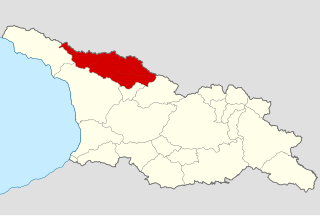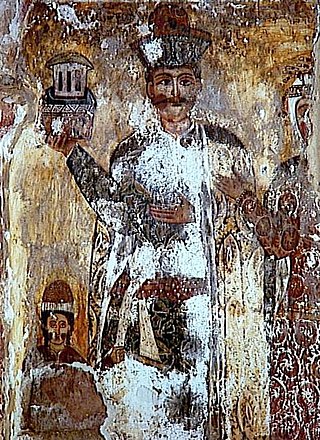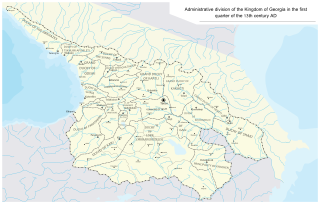
The Kingdom of the Iberians was a medieval Georgian monarchy under the Bagrationi dynasty which emerged circa 888 AD, succeeding the Principality of Iberia, in historical region of Tao-Klarjeti, or upper Iberia in north-eastern Turkey as well parts of modern southwestern Georgia, that stretched from the Iberian gates in the south and to the Lesser Caucasus in the north.

Svaneti or Svanetia is a historic province in the northwestern part of Georgia. Running along the Greater Caucasus range, Svaneti is one of the most mountainous regions of Georgia. It is largely inhabited by the Svans, an ethnic subgroup of Georgians.

Racha is a highland area in western Georgia, located in the upper Rioni river valley and hemmed in by the Greater Caucasus mountains. Under Georgia's current subdivision, Racha is included in the Racha-Lechkhumi and Kvemo Svaneti region (mkhare) as the municipalities of Oni and Ambrolauri.
For articles related to Georgia, see Category:Georgia (country)

The Duchy of Kldekari, sometimes also referred as County of Trialeti was a duchy (saeristavo) within the kingdom of Georgia from 876-1184. Ruled by a powerful dynasty of Liparitids-Baghuashi, the duchy existed in the south-western parts of modern Kvemo Kartli province, and, despite its small size, created problems for the Bagrationi kings as they sought to bring all Georgian vassals and principalities into a unified state.

Lechkhumi is a historic province in northwestern Georgia which comprises the area along the middle basin of the Rioni and Tskhenistskali and also the Lajanuri river valley. Now part of the Racha-Lechkhumi and Kvemo Svaneti region, it corresponds roughly to the present day Tsageri district as well as parts of districts of Tsq'altubo and Ambrolauri. It is bordered by Mingrelia to the west, Svaneti to the north, Racha to the east, and Imereti to the south.
Guaram, the mampali, was a Georgian Bagratid prince and the youngest son of Ashot I, the founder of the Bagratid dynasty of Iberia/Kartli.
David I was a Georgian Bagratid Prince and curopalates of Iberia/Kartli from 876 to 881. He was murdered by Nasra of Tao-Klarjeti, who self-proclaimed as his successor. David's death led to an inter-dynastic feud under David's only son Adarnase, who eventually, in 888, avenged the killing of his father.

Racha-Lechkhumi and Kvemo Svaneti is a region (mkhare) in northwestern Georgia with a population of 28,500 (2021), making it the most sparsely populated region in the country. It has a nominal area of 4,954 km2 (1,913 sq mi), of which 4,600 km2 (1,800 sq mi) is de facto controlled by Georgia. The remainder is effectively under South Ossetian control. The region has Ambrolauri as its administrative center and Parmen Margvelidze is governor of the region since June 2021. Racha-Lechkhumi and Kvemo Svaneti includes the historical provinces of Racha, Lechkhumi and Kvemo Svaneti.
The Catholicate of Abkhazia was a subdivision of the Georgian Orthodox Church that existed as an independent entity in western Georgia from the 1470s to 1814. It was headed by the Catholicos, officially styled as the Catholicos Patriarch of Imereti, Odishi, Ponto-Abkhaz-Guria, Racha-Lechkhum-Svaneti, Ossetians, Dvals, and all of the North. The residence of the Catholicoi was at Bichvinta in Abkhazia, but was moved to the Gelati Monastery in Imereti in the late 16th century. In 1814, the office of the Catholicos of Abkhazia was abolished by the Russian Empire which would take control of the Georgian church until 1917.
Adarnase Shavliani was the King of Abkhazia between 880 and 887. He succeeded his father, the usurper John Shavliani, to the throne but was deposed and put to death by Bagrat I, the son of Demetrius II.
Bagrat I was the King of Abkhazia between 882 and 894. He was the second son of Demetrius II of the Anchabadze dynasty.
Adarnase IV was a member of the Georgian Bagratid dynasty of Tao-Klarjeti and prince of Iberia, responsible for the restoration of the Iberian kingship, which had been in abeyance since it had been abolished by Sasanian Empire in the 6th century, in 888.
Gurgen II "the Great" was a Georgian prince of the Bagratid dynasty of Tao-Klarjeti and hereditary ruler of Tao with the title of eristavt-eristavi, "duke of dukes". He also bore the Byzantine title of magistros.
Vardan I Dadiani was a Georgian noble and the forefather of the Dadiani, the princely dynasty of Samegrelo (Mingrelia), a region in western Georgia which Vardan ruled as eristavi ("duke") from 1183 to 1213. He was a prominent courtier of Queen Tamar of Georgia, but fell out of favor after leading an abortive rebellion in support of Tamar's disgraced former husband George the Rus' in 1191.
Mamia III Dadiani was a member of the House of Dadiani and eristavi ("duke") of Odishi, that is, Mingrelia, in western Georgia from 1512 until his death. Mamia was a son and successor of Liparit II Dadiani, who had emerged as a semi-independent ruler in the process of dissolution of the Kingdom of Georgia. Mamia was culturally active in Abkhazia and continued his predecessors' efforts to secure borders against the North Caucasian mountainous tribes of Zygia. His naval expedition against them and landing in Zygia ended in a fiasco and Mamia was killed in battle.

Levan I Dadiani was a member of the House of Dadiani and ruler of Odishi, that is, Mingrelia, in western Georgia. He succeeded on the death of his father, Mamia III Dadiani, as eristavi ("duke") of Odishi and ex officio mandaturt-ukhutsesi of Imereti in 1533. Dadiani's break with the king of Imereti brought about his downfall and imprisonment in 1546. He was able to escape and regain his possessions, securing Ottoman support for his independence from Imereti.

The Duchy of Tskhumi was a duchy (saeristavo) in a medieval Georgia. Ruled by a House of Shervashidze, the duchy existed from 8th to 14th century, in the north-western part of Georgia and comprised territories around modern Sukhumi, Georgia.

The collapse of the Georgian realm was a political and territorial fragmentation process that resulted in the dynastic triumvirate military conflict of the Bagrationi monarchs and war of succession in the united Kingdom of Georgia culminating during the second half of the 15th century.









